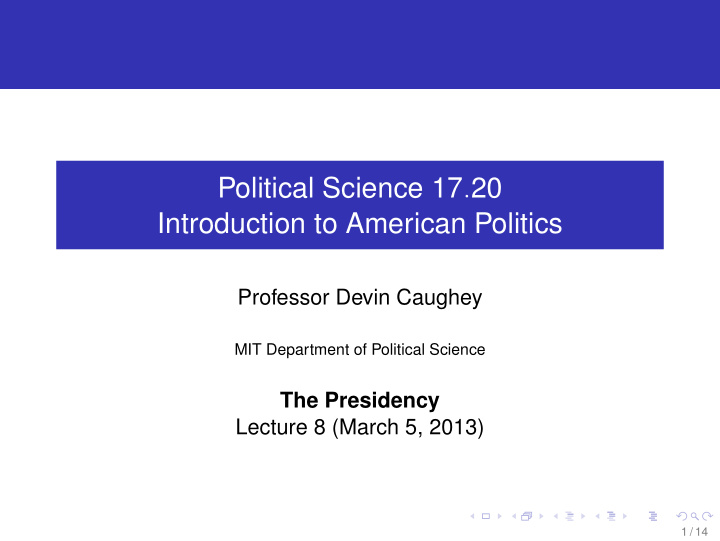



Political Science 17 . 20 Introduction to American Politics Professor Devin Caughey MIT Department of Political Science The Presidency Lecture 8 (March 5, 2013) 1 / 14
Outline The Evolving Presidency 1 Strategies of Modern Presidents 2 Unilateral Action and Pivotal Politics 3 2 / 14
Outline The Evolving Presidency 1 Strategies of Modern Presidents 2 Unilateral Action and Pivotal Politics 3 3 / 14
The Constitutional Presidency Enumerated Powers Veto → negative power to check Congress Appointment → friendly personnel, patronage Commander-in-Chief → act decisively in time of war “Take Care” Clause → execute laws (ambiguous) → Independent selection and powers (not Congress’s agent) 4 / 14
The 19th-Century Presidency Congressional government President as clerk of small bureaucracy Small peacetime military establishment President’s relationship with people mediated by party President as agent of his party (patronage) 5 / 14
The Rise of the Modern Presidency The president as leader of the nation: Communicate directly with people (newspapers, radio, TV) Elected representative of the whole nation (mandate) Embodiment of whole government (held responsible) Increasing presidential resources and responsibilities: Growth of national government and bureaucracy Congressional delegation to president Cold War → permanent military establishment 6 / 14
Outline The Evolving Presidency 1 Strategies of Modern Presidents 2 Unilateral Action and Pivotal Politics 3 7 / 14
The Power to Persuade Neustadt (1960): President has little power of direct command, even over the bureaucracy Demands exceed actual capacity Presidential power is the “power to persuade” → Get others to want what he wants through skillful deployment of resources in bargaining with power holders 8 / 14
Going Public Kernell (1986): Mass media allow the president to communicate directly with the people. Set agenda and put electoral pressure on Congress Public threats rather than private bargaining Baum & Kernell (1999/2010): Rise of cable and end of network oligopoly lessened presidents of ability to command the public’s attention, esp. the least politically interested (most persuadable) 9 / 14
The Power of Command Moe & Howell (1999): President’s power of command underrated Executive orders, international agreements, military deployments. . . President able to make law unilaterally, without the consent of Congress 10 / 14
Outline The Evolving Presidency 1 Strategies of Modern Presidents 2 Unilateral Action and Pivotal Politics 3 11 / 14
Power and Ambiguity Framers’ Assumption: All politicians seek more power, so “ambition must be made to counter ambition.” Presidents seek power, but Congress seeks reelection → Why might reelection-focused MCs give up power? 12 / 14
Presidential Advantages Ambiguity of Constitution (incomplete contract) Congressional delegation, but little control over agent Informational asymmetry Congressional power is a collective good Presidential appointment of Supreme Court First-mover advantage (veto points, fait accomplis) 13 / 14
Pivotal Politics SQ 1 C m SQ 2 SQ 2 P V (A) Legislative politics SQ 1 C m V SQ 2 P (B) Unilateral politics The legislative advantages of unilateral action. Image by MIT OpenCourseWare. 14 / 14
MIT OpenCourseWare http://ocw.mit.edu 17.20 Introduction to American Politics Spring 2013 For information about citing these materials or our Terms of Use, visit: http://ocw.mit.edu/terms .
Recommend
More recommend